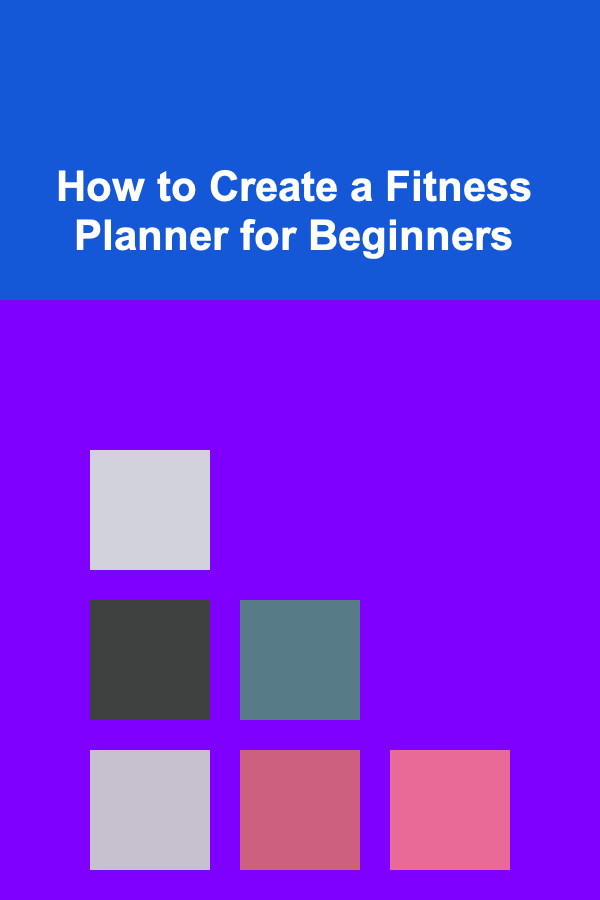
How to Create a Fitness Planner for Beginners
ebook include PDF & Audio bundle (Micro Guide)
$12.99$9.99
Limited Time Offer! Order within the next:

Starting a fitness journey can be both exciting and overwhelming, especially for beginners. With so much information available, it's easy to feel lost or unsure about where to begin. One of the most effective ways to stay on track and make progress is by creating a fitness planner. A fitness planner can help you set goals, track your workouts, monitor your nutrition, and ultimately stay committed to a healthier lifestyle. Whether your goal is weight loss, muscle gain, or simply improving your overall well-being, a fitness planner can serve as your roadmap to success.
In this article, we will walk you through the essential steps to create a fitness planner that is not only effective but also sustainable. This guide will cover everything from setting achievable goals to tracking progress, designing your workout schedule, and ensuring you stay motivated throughout your fitness journey.
Define Your Fitness Goals
The first step in creating an effective fitness planner is to define your goals. Fitness goals give you a sense of direction and purpose, helping you stay focused and motivated. Whether you're aiming to lose weight, build muscle, improve flexibility, or enhance cardiovascular health, setting clear and specific goals is essential.
Types of Fitness Goals
- Weight Loss: If your primary goal is to lose weight, you should aim for a sustainable rate of weight loss, typically 1-2 pounds per week. Focus on improving your diet and engaging in regular physical activity to create a calorie deficit.
- Muscle Gain: If you're looking to build muscle, you'll need to focus on strength training exercises and consume an adequate amount of protein to support muscle growth. Your goal could be to increase the amount of weight you lift over time or to see a noticeable difference in muscle definition.
- Cardiovascular Health: If improving cardiovascular health is your focus, your goals might revolve around improving endurance, increasing stamina, or reducing resting heart rate. Activities like running, cycling, swimming, and aerobics are great for this.
- Flexibility and Mobility: Some people may have flexibility and mobility goals, which can be achieved through activities like yoga, Pilates, or stretching exercises. Tracking the progress of your flexibility can also serve as a great motivation booster.
SMART Goals
When defining your fitness goals, it's helpful to use the SMART criteria:
- Specific: Clearly define what you want to achieve.
- Measurable: Track your progress through quantifiable metrics, such as weight loss, strength increases, or distance run.
- Achievable: Set goals that are realistic and attainable based on your current fitness level.
- Relevant: Ensure your goals align with your overall health objectives and personal interests.
- Time-bound: Set a deadline to reach your goals, whether it's within a few weeks, months, or a year.
Design Your Workout Schedule
A workout schedule is the backbone of any fitness plan. It ensures that you stay consistent and progressively challenge your body to improve. As a beginner, it's important to start slow and gradually increase the intensity of your workouts to avoid burnout or injury.
Choose Your Workout Types
There are several types of workouts that you can include in your fitness planner. Depending on your goals, you may want to focus on a combination of strength training, cardiovascular exercises, and flexibility training.
- Strength Training: Incorporating weightlifting or bodyweight exercises (like push-ups, squats, and lunges) will help build muscle mass, increase metabolism, and improve overall strength.
- Cardio: Cardiovascular exercises are crucial for improving heart health and burning calories. Activities like running, cycling, brisk walking, swimming, or HIIT (high-intensity interval training) can be incorporated into your workout routine.
- Flexibility and Mobility: Stretching or yoga exercises should be part of your weekly workout plan to enhance flexibility, mobility, and recovery.
- Rest Days: Don't forget to schedule rest days into your workout routine. Rest is essential for muscle recovery, preventing overtraining, and ensuring long-term progress.
Beginner Workout Plan
For beginners, it's important not to overdo it in the beginning. A sample workout plan could look like this:
- Monday: Full-body strength training (45 minutes)
- Tuesday: Cardio (30 minutes of moderate-intensity running or cycling)
- Wednesday: Rest or active recovery (light yoga or stretching)
- Thursday: Lower body strength training (45 minutes)
- Friday: Cardio (HIIT for 20-30 minutes)
- Saturday: Upper body strength training (45 minutes)
- Sunday: Rest
Remember to listen to your body and adjust the intensity and frequency of your workouts as you become more comfortable.
Track Your Nutrition
Fitness is not just about exercise; nutrition plays a critical role in achieving your goals. Whether you're trying to lose weight, gain muscle, or improve overall health, tracking what you eat is essential for success.
Set Nutritional Goals
Just like fitness goals, your nutritional goals should be specific and measurable. For example, you might set a goal to consume a certain number of calories per day, increase your protein intake to support muscle growth, or reduce processed foods to improve overall health.
- Calorie Intake: If you're looking to lose weight, you'll need to create a calorie deficit by consuming fewer calories than you burn. On the other hand, if you're aiming to build muscle, you'll need a slight calorie surplus.
- Macronutrient Breakdown: Pay attention to your macronutrients---carbohydrates, proteins, and fats. For beginners, a balanced diet that includes all three is important. If you're building muscle, you may want to focus on increasing protein intake.
- Meal Planning: Include a weekly meal plan in your fitness planner. Having a plan helps you stay organized, avoid impulse eating, and ensure you're consuming the right nutrients to support your fitness goals.
Tracking Tools
There are several tools available to help track your food intake:
- Food Diary: Write down everything you eat each day. This can help you stay accountable and aware of your eating habits.
- Nutrition Apps: Many apps, like MyFitnessPal or Cronometer, allow you to log your meals and track your calories and macronutrients.
- Meal Prep: Consider preparing your meals in advance to avoid unhealthy food choices and save time during the week.
Include Progress Tracking
Tracking your progress is key to staying motivated and understanding how your body is responding to your workouts and nutrition. There are several ways to track your fitness progress effectively.
Physical Measurements
- Weight: Tracking your weight is one way to monitor progress, but it shouldn't be your only metric. Your weight can fluctuate due to many factors, including water retention and muscle gain.
- Body Measurements: Measure your waist, hips, chest, arms, and legs. This will give you a better picture of how your body is changing over time.
- Body Fat Percentage: If possible, measure your body fat percentage using a scale, calipers, or a body composition analysis at a gym. This metric can be more telling than weight alone.
Fitness Milestones
- Strength: Track your progress by recording the amount of weight you're lifting or the number of repetitions you can do for different exercises.
- Endurance: Monitor improvements in cardiovascular health by tracking your running distance, pace, or the amount of time you can maintain a certain intensity level.
- Flexibility: Keep track of how your flexibility improves over time by recording your ability to touch your toes, perform certain yoga poses, or stretch.
Weekly and Monthly Check-ins
At the end of each week or month, review your progress and make adjustments as necessary. If you've made significant progress, celebrate those victories, no matter how small. If you haven't met your goals, reassess your routine and nutrition to identify areas for improvement.
Stay Motivated and Consistent
Consistency is key when it comes to fitness, but it can sometimes be difficult to stay motivated. A fitness planner can help you stay on track by keeping your goals, workout plans, and progress organized. Here are a few ways to keep your motivation high:
- Set Mini Goals: Break down your larger goals into smaller, more manageable tasks. Celebrate each milestone to maintain momentum.
- Find a Workout Buddy: Having a friend to work out with can make the process more enjoyable and help you stay accountable.
- Track Non-Scale Victories: Don't focus solely on the numbers. Celebrate improvements in how you feel, your energy levels, or your strength.
- Reward Yourself: Treat yourself when you hit a milestone, whether it's a new workout gear item or a massage to help with recovery.
Evaluate and Adjust Your Plan
As you progress in your fitness journey, your goals and abilities will evolve. Periodically evaluate your fitness planner to ensure that it still aligns with your current needs.
- Reassess Your Goals: If you've achieved a goal, set a new one to continue progressing. If a goal no longer aligns with your priorities, adjust it accordingly.
- Adjust Your Routine: As your fitness level improves, your workouts may need to be more challenging. Increase the intensity, add new exercises, or adjust the frequency of your workouts to continue progressing.
Conclusion
Creating a fitness planner as a beginner is an empowering step toward reaching your health and fitness goals. By defining your goals, designing a workout schedule, tracking your nutrition, monitoring your progress, and staying motivated, you'll have all the tools you need to succeed. Remember, fitness is a journey, and consistency is the key to long-term results. With a well-organized fitness planner, you can stay focused, motivated, and on the path to achieving the healthy lifestyle you desire.
Reading More From Our Other Websites
- [Personal Care Tips 101] How to Keep Your Clothes Fresh Using Antiperspirant
- [Biking 101] Triathlon Bike vs. Road Bike: Which One Is Right for You?
- [Home Cleaning 101] How to Plan External House Cleaning Around Weather Conditions
- [Personal Care Tips 101] How to Show Yourself and Others Compassion in Difficult Times
- [Home Space Saving 101] How to Organize a Cramped Closet with Limited Space
- [Beachcombing Tip 101] Identifying the Most Coveted Seashells: A Quick Reference for Collectors
- [Home Soundproofing 101] How to Soundproof a Wall for Maximum Noise Reduction
- [Home Soundproofing 101] How to Use Door Sweeps for Better Soundproofing in Your Home
- [Home Lighting 101] How to Choose the Right Light Bulbs for Each Room
- [Home Pet Care 101] How to Keep Your Pet Safe from Household Hazards

How To Choose the Best Cooler for Car Camping
Read More
How to Plan a Stress-Free Home Party for Large Groups
Read More
The Impact of Continuing Education on Your Job Search
Read More
How to Grill Vegetables to Smoky Perfection
Read More
How to Cultivate Self-Compassion
Read More
How to Create a Board Game Night Checklist for Beginners
Read MoreOther Products

How To Choose the Best Cooler for Car Camping
Read More
How to Plan a Stress-Free Home Party for Large Groups
Read More
The Impact of Continuing Education on Your Job Search
Read More
How to Grill Vegetables to Smoky Perfection
Read More
How to Cultivate Self-Compassion
Read More